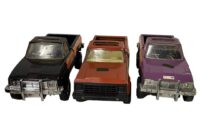New FedEx Trucks For Sale: A Comprehensive Guide for Independent Contractors sale.truckstrend.com
In the dynamic and ever-expanding world of logistics, the backbone of any successful delivery operation is its fleet. For independent service providers (ISPs) and linehaul contractors partnered with FedEx, investing in reliable, efficient, and compliant vehicles is not just an option—it’s a fundamental necessity. While FedEx itself does not typically sell brand-new trucks directly to the public, the term "New FedEx Trucks For Sale" refers to the acquisition of brand-new commercial vehicles specifically configured, upfitted, and purchased for the purpose of fulfilling FedEx delivery routes. This comprehensive guide will navigate the crucial aspects of selecting, acquiring, and managing these essential assets, offering insights for both seasoned operators and those looking to enter the lucrative FedEx contracting business.
The e-commerce boom has dramatically amplified the demand for package delivery services, making FedEx routes highly sought after. To meet this demand and ensure operational excellence, contractors frequently seek new vehicles. Opting for a new truck represents a significant investment, but it promises enhanced reliability, improved fuel efficiency, advanced safety features, and a competitive edge in a demanding market. Understanding the nuances of this investment is paramount for long-term success.
New FedEx Trucks For Sale: A Comprehensive Guide for Independent Contractors
Understanding the FedEx Fleet & Contractor Model
FedEx operates through a complex network of company-owned assets and, crucially, independent contractors. FedEx Ground and FedEx Home Delivery services rely heavily on these ISPs, who own their routes, employ their drivers, and are responsible for their own vehicles. This model gives contractors significant autonomy but also places the onus of vehicle acquisition and maintenance squarely on their shoulders.
For ISPs, the vehicle is their primary tool. It must be robust enough to handle daily wear and tear, capacious enough for a full day’s worth of packages, and reliable enough to meet strict delivery windows. New trucks, therefore, are often seen as a strategic investment, offering peace of mind and operational consistency that older, used vehicles might not.
Why Invest in New Trucks for FedEx Routes?
While the initial sticker price of a new truck can be daunting, the benefits often outweigh the challenges for serious operators:
- Unmatched Reliability: New vehicles come with zero mileage (or very low), ensuring all components are fresh. This significantly reduces the likelihood of unexpected breakdowns, which can lead to missed deliveries, service failures, and ultimately, financial penalties or loss of routes.
- Manufacturer Warranty: New trucks are backed by comprehensive manufacturer warranties, covering major components and systems for a specified period or mileage. This provides crucial protection against unforeseen mechanical issues, drastically lowering initial maintenance and repair costs.
- Enhanced Fuel Efficiency: Modern engines and vehicle designs are engineered for better fuel economy. While marginal gains per mile might seem small, they accumulate significantly over hundreds of thousands of miles, leading to substantial savings on one of the largest operational expenses.
- Advanced Safety Features: New trucks are equipped with the latest safety technologies, including advanced driver-assistance systems (ADAS) like collision mitigation, lane departure warning, adaptive cruise control, and improved braking systems. These features protect drivers, reduce the risk of accidents, and can even lower insurance premiums.
- Lower Initial Maintenance Costs: For the first few years, new trucks typically require only routine preventative maintenance, such as oil changes and tire rotations. This predictability in maintenance expenses simplifies budgeting and reduces downtime.
- Improved Driver Comfort and Retention: Modern cabs offer better ergonomics, air conditioning, infotainment systems, and quieter rides. A comfortable driver is a productive and happier driver, contributing to higher retention rates in an industry often plagued by driver shortages.
- Compliance and Brand Image: New trucks are inherently compliant with current emissions standards and often present a more professional image. A well-maintained, new fleet reflects positively on the contractor and, by extension, on FedEx.
- Higher Resale Value: While depreciation is a factor, well-maintained new trucks generally retain a higher percentage of their value compared to older, higher-mileage vehicles when it’s time to upgrade or sell.


Challenges to Consider:
- Higher Upfront Cost: This is the most significant hurdle. New trucks require substantial capital investment or robust financing.
- Depreciation: Vehicles begin to depreciate the moment they are driven off the lot.
- Financing Requirements: Lenders often require a strong credit history, a substantial down payment, and a clear business plan for commercial vehicle loans.

Types of New Trucks Suitable for FedEx Routes
The type of truck needed depends heavily on the specific FedEx route (Ground, Home Delivery, or Linehaul) and the volume/size of packages.
-
Package Delivery Vans (Cargo Vans):
- Description: These are the most common vehicles for last-mile delivery. They are agile, relatively fuel-efficient, and easy to maneuver in residential areas. They come in various sizes (e.g., 1500, 2500, 3500 series) with different roof heights and wheelbase options.
- Common Models:
- Mercedes-Benz Sprinter: Known for reliability, fuel efficiency, and comfortable interior.
- Ford Transit: Highly customizable, good cargo capacity, and a range of engine options.
- Ram ProMaster: Front-wheel drive for better traction, low load floor, and good maneuverability.
- Nissan NV: Robust and spacious, though production for new models has ceased in some markets, remaining stock may be available.
- Suitability: Ideal for residential and lighter commercial routes, typically for FedEx Home Delivery and lighter FedEx Ground routes.
-
Walk-in/Step Vans:
- Description: Purpose-built for package delivery, offering stand-up headroom, easy access to cargo, and robust construction. Drivers can quickly move from the driving position to the cargo area.
- Common Models:
- Freightliner MT45/MT55 Chassis with Utilimaster or Morgan Olson Body: These are iconic "bread truck" style vehicles, designed for high-volume, frequent-stop deliveries. They are highly durable and can be customized with shelving, bulkheads, and advanced telematics.
- Suitability: Essential for high-volume FedEx Ground routes, especially in dense commercial or suburban areas, where efficiency of loading/unloading and driver access is paramount.
-
Box Trucks (Straight Trucks):
- Description: Larger trucks with a separate cargo box mounted on a truck chassis. They offer significantly more cargo volume and payload capacity than vans or step vans.
- Common Models:
- Ford F-Series (F-650/F-750), Freightliner M2, Hino, Isuzu N-Series: Often paired with cargo bodies from manufacturers like Morgan, Supreme, or Utilimaster.
- Suitability: Used for very large FedEx Ground routes, bulk deliveries, or as part of a contractor’s linehaul operation for moving packages between hubs. Less common for typical last-mile delivery due to their size and maneuverability.
Key Features and Specifications to Look For
When purchasing a new truck for FedEx routes, consider these critical specifications:
- Cargo Capacity: Measured in cubic feet, this determines how many packages a truck can hold. Match capacity to your route’s typical volume.
- Payload Capacity: The maximum weight a truck can carry (including cargo, driver, and fuel). This is crucial for avoiding overloading and ensuring safety/compliance.
- Gross Vehicle Weight Rating (GVWR): The maximum operating weight of the truck as specified by the manufacturer. This impacts licensing, CDL requirements (for vehicles over 26,001 lbs), and DOT regulations. Most delivery vans and step vans are under this threshold, but larger box trucks may exceed it.
- Fuel Efficiency: Look at the engine type (gasoline vs. diesel), transmission, and aerodynamic design.
- Maneuverability: A tight turning radius is vital for navigating tight streets, cul-de-sacs, and loading docks.
- Safety Features: Prioritize features like backup cameras, parking sensors, blind-spot monitoring, electronic stability control, and advanced braking systems.
- Ergonomics and Driver Comfort: Adjustable seats, climate control, easy-to-reach controls, and good visibility reduce driver fatigue.
- Upfitting and Customization: Ensure the vehicle can be properly upfitted with shelving, lighting, bulkheads, and security features specific to FedEx operations. Many dealers work directly with upfitters.
- Telematics Integration: Compatibility with fleet management software and GPS tracking systems.
The Buying Process: Where and How to Acquire New Trucks
Acquiring new trucks for FedEx routes typically involves several steps:
- Assess Your Needs: Analyze your current or prospective FedEx route’s volume, package size, and mileage. This will dictate the type and size of truck required.
- Research Manufacturers and Models: Identify specific models from reputable manufacturers that meet your criteria.
- Find Reputable Dealerships:
- Commercial Vehicle Dealerships: Ford, Mercedes-Benz, Ram, Freightliner, Hino, Isuzu, and other commercial truck dealerships specialize in selling new fleet vehicles. Many have dedicated commercial sales teams.
- Specialized Upfitters/Body Builders: Companies like Utilimaster and Morgan Olson build the bodies for step vans and can often facilitate the purchase of the complete vehicle (chassis + body).
- Explore Financing Options:
- Commercial Loans: Banks and credit unions offer commercial vehicle loans with varying terms and interest rates. A strong business plan and credit history are essential.
- Leasing: Operating leases can offer lower monthly payments and flexibility, allowing you to return the truck at the end of the term or purchase it. Capital leases are more akin to purchasing with an option to buy.
- Manufacturer Financing: Many vehicle manufacturers offer their own financing programs, sometimes with competitive rates or special incentives.
- SBA Loans: Small Business Administration (SBA) loans can be a good option for small businesses, offering favorable terms.
- Obtain Quotes and Negotiate: Get quotes from multiple dealerships. Be prepared to negotiate on price, financing terms, and any included upfitting or service packages.
- Consider Fleet Purchasing Programs: If you plan to purchase multiple vehicles, inquire about fleet discounts or programs offered by manufacturers or dealerships.
- Upfitting and Branding: Once purchased, the truck will need to be upfitted (shelving, lighting, safety features) and branded with FedEx-approved decals and paint schemes. Many dealers coordinate with preferred upfitters.
- Insurance and Registration: Secure appropriate commercial auto insurance coverage (which FedEx requires) and register the vehicle in your business’s name.
Important Considerations & Regulations
- FedEx Vehicle Requirements: FedEx has specific requirements for vehicle appearance, safety features, and often, branding. Ensure your chosen new truck and its upfit comply with these standards to avoid service failures.
- Department of Transportation (DOT) and FMCSA Regulations: If your truck’s GVWR exceeds certain thresholds (e.g., 10,000 lbs for interstate commerce), it falls under DOT regulations, requiring DOT numbers, driver logs (for certain operations), and regular inspections. For vehicles over 26,001 lbs GVWR, a Commercial Driver’s License (CDL) is required. Most standard delivery vans and step vans are below the CDL threshold.
- Insurance: Comprehensive commercial insurance is mandatory. This includes liability, collision, comprehensive, and potentially cargo insurance.
- Maintenance Schedule and Warranty: Adhere strictly to the manufacturer’s recommended maintenance schedule to keep your warranty valid and ensure the longevity of your vehicle.
- Total Cost of Ownership (TCO): Look beyond the purchase price. Factor in fuel, insurance, maintenance, tires, registration, and potential downtime when calculating the true cost of owning and operating a new truck.
- Future-Proofing: Consider emerging technologies like electric vehicles (EVs) or alternative fuels. While the upfront cost for new EV delivery vans is higher, lower operating costs (fuel, maintenance) and potential incentives might make them viable long-term options for certain routes.
Practical Advice and Actionable Insights
- Know Your Route Intimately: Before buying, analyze the average package weight, volume fluctuations, daily mileage, and road conditions of your route. This data is invaluable for choosing the right truck.
- Budget Beyond the Sticker Price: Include taxes, registration, insurance, upfitting, and initial maintenance costs in your budget.
- Build Relationships with Dealers: A good commercial vehicle sales representative can be a valuable partner, helping you navigate options, financing, and after-sales service.
- Network with Other ISPs: Experienced FedEx contractors are a wealth of knowledge regarding vehicle performance, reliable dealerships, and common challenges.
- Understand Financing Terms: Read all loan or lease agreements carefully. Pay attention to interest rates, repayment schedules, penalties, and end-of-term options.
- Prioritize Safety: Investing in advanced safety features protects your driver and your investment, potentially reducing insurance claims and improving your safety record.
- Plan for Maintenance: Even new trucks need regular servicing. Budget for preventative maintenance and establish a relationship with a reliable service center.
Concluding Summary
Investing in new trucks for FedEx routes is a critical strategic decision for independent service providers. While the initial capital outlay is significant, the benefits of enhanced reliability, improved efficiency, advanced safety, and reduced long-term maintenance costs often make it a worthwhile endeavor. By carefully assessing route needs, understanding vehicle types and specifications, navigating the purchasing and financing landscape, and adhering to regulatory requirements, contractors can build a robust, efficient, and compliant fleet. This informed approach not only ensures operational success but also positions businesses for growth in the ever-evolving world of logistics. The road ahead for FedEx contractors is paved with opportunity, and the right new truck is the vehicle to seize it.
New FedEx Trucks For Sale: Estimated Price Table
Please note: These prices are estimated ranges for brand-new commercial vehicles suitable for FedEx routes. Actual prices vary significantly based on manufacturer, model, specific configurations, engine type, optional features, upfitting requirements, market conditions, dealership promotions, and negotiation. These figures do not include taxes, registration, insurance, or post-purchase branding/decals unless specified by a package.
| Vehicle Type | Common Models / Chassis | Key Features | Estimated Price Range (USD) |
|---|---|---|---|
| Cargo Vans | Ford Transit, Mercedes-Benz Sprinter, Ram ProMaster | High roof, extended length options, various GVWRs (1500, 2500, 3500 series), gasoline or diesel engines, advanced driver-assistance systems (ADAS), customizable interiors for shelving. | $45,000 – $80,000+ |
| Walk-in / Step Vans | Freightliner MT45/MT55 Chassis (with Utilimaster/Morgan Olson body) | Purpose-built for delivery, stand-up height, easy cargo access, heavy-duty construction, robust chassis, customizable shelving and lighting, often diesel-powered, high payload capacity. | $90,000 – $150,000+ |
| Box Trucks | Ford F-650/F-750, Hino, Isuzu N-Series (with 16-26 ft box) | Higher payload and cargo volume, various box lengths, roll-up or swing doors, liftgates optional, often diesel engines, suitable for larger or linehaul routes. GVWR can exceed 26,000 lbs requiring CDL. | $80,000 – $180,000+ |
| Electric Delivery Vans | Ford E-Transit, Rivian EDV (for Amazon), BrightDrop Zevo 400/600 | Zero emissions, lower operating costs (fuel/maintenance), potentially eligible for incentives, quieter operation. Still a developing market, limited availability for some models. | $70,000 – $120,000+ |
Note: Prices for electric vehicles are currently higher than their internal combustion engine (ICE) counterparts, but total cost of ownership (TCO) may be lower over time due to reduced fuel and maintenance expenses.
Frequently Asked Questions (FAQ) about New FedEx Trucks For Sale
Q1: Does FedEx itself sell new trucks to the public or contractors?
A1: No, FedEx generally does not sell its own brand-new fleet vehicles directly to independent contractors or the public. The term "New FedEx Trucks For Sale" refers to independent contractors purchasing brand-new commercial vehicles (from manufacturers like Ford, Mercedes-Benz, Freightliner, etc.) that are then used to operate FedEx routes.
Q2: Are new trucks required to operate a FedEx route?
A2: No, new trucks are not strictly required. Many contractors start with reliable used vehicles. However, new trucks offer significant advantages in terms of reliability, warranty, fuel efficiency, and safety, which can lead to lower operating costs and better performance over time.
Q3: What’s the best type of new truck for a FedEx Ground route?
A3: For most FedEx Ground routes, especially those with higher package volumes, a new walk-in or step van (like a Freightliner MT45/MT55 chassis with a Utilimaster or Morgan Olson body) is often considered the best choice due to its efficiency for frequent stops and high cargo capacity. For lighter or more residential routes, a high-roof cargo van (Sprinter, Transit, ProMaster) can be suitable.
Q4: How long do new FedEx trucks typically last?
A4: With proper maintenance, a new commercial delivery truck can last anywhere from 300,000 to 500,000 miles or more, often providing 5-10+ years of reliable service in a high-demand delivery environment. The lifespan depends heavily on the model, route conditions, and adherence to maintenance schedules.
Q5: Can I finance a new FedEx truck?
A5: Yes, commercial vehicle financing is widely available through banks, credit unions, and manufacturer financing programs. Lenders typically look for a solid business plan, a good credit history, and often require a down payment. Both loans and leases are common options.
Q6: What are the main ongoing costs of operating a new FedEx truck?
A6: Key ongoing costs include fuel, insurance (commercial auto insurance is mandatory and often higher than personal insurance), preventative maintenance, tires, registration fees, and potential repair costs (though lower in the initial years for new trucks).
Q7: Do I need a Commercial Driver’s License (CDL) to drive a FedEx truck?
A7: For most standard FedEx Ground and Home Delivery routes, a CDL is not required. The majority of delivery vans and step vans have a Gross Vehicle Weight Rating (GVWR) under 26,001 pounds. However, if you purchase a larger box truck or a truck with a GVWR exceeding 26,001 pounds, a CDL would be necessary. Always verify the GVWR of any truck you consider.
Q8: Are electric delivery trucks a viable option for new FedEx contractors?
A8: Electric delivery vans are becoming increasingly viable, especially for routes with predictable daily mileage and access to charging infrastructure. While their upfront cost is currently higher, they offer significantly lower "fuel" (electricity) and maintenance costs, and potential government incentives. They are a strong consideration for future-proofing your fleet.




